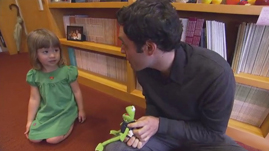Teachers' Domain - Digital Media for the Classroom and Professional Development
User: Preview

Source: The Human Spark: "Brain Matters"




Major funding for The Human Spark is provided by the National Science Foundation, and by the Alfred P. Sloan Foundation. Additional funding is provided by the John Templeton Foundation, the Cheryl and Philip Milstein Family, and The Winston Foundation.
ALAN ALDA We are trying to figure out the Human Spark, what makes us human, and we certainly do seem to be very different from the other animals.
ELIZABETH SPELKE To say the least…
ALAN ALDA So are we born with something that right off the bat that make us vastly different?
ELIZABETH SPELKE I don’t think so. This is a question that I’ve been trying to answer for the last 30 years or so, and for most of that time, my hunch was that we were, that we would see in infants systems of knowledge that human infants alone would display. But when we look hard at what a four month old or six month old infant can do, we see very close similarities between the capacities of human infants and the capacities of infants and adults of other species. So I don’t think that that Human Spark ignites early in development.
ALAN ALDA What would bring it about, are we very reliant on this culture that we have?
ELIZABETH SPELKE I think that’s a great question, and one that’s very debated right now. My personal view is that what’s most central to the sparking of uniquely human cognitive capacities is our capacity for language, and its when children really get going on the task of learning language, learning their first words at 9 or 10 months of age, putting words together a few months later, that’s when we start seeing these uniquely human capacities emerging.
ALAN ALDA (NARRATION) So Liz Spelke sees language as igniting the Human Spark. She’s exploring that idea by studying how language allows children to interpret maps as representing the real world.
ELIZABETH SPELKE So you take a 2 1/2 year old child and show them a two-dimensional drawing that simply has a simple geometric figure on it, say a triangle, and say to them:
NATHAN WINKLER-RHOADES Nora, guess what. Kermit. He has a favorite bucket that he likes to sit in. There is one bucket that he likes the best, and today we are going to put him in his favorite bucket, OK? Here’s our picture of the room. There’s one bucket, there’s another bucket and there’s another bucket. Kermit, which one is your favorite bucket? “My favorite is this one, right here.” Oh, Kermit said that this one is his favorite. Nora, can you put Kermit in his favorite bucket? Yay!
ELIZABETH SPELKE That’s a remarkable ability. But if you ask what you have done with this child to engage this ability, to engage this symbolic function, you have talked to them, you told them…
NATHAN WINKLER-RHOADES There’s one bucket, there’s another bucket and there’s another bucket…
ELIZABETH SPELKE And that raised the question, what if you didn’t do that? What if you simply showed them the piece of paper and said:
NATHAN WINKLER-RHOADES There’s one, and there’s another, and there’s another. Now, Kermit, which is your favorite one? “My favorite one is this one, right here.”
ALAN ALDA (NARRATION) Notice that unlike Nora, Xander isn’t told that the spot on the map represents a bucket.
NATHAN WINKLER-RHOADES Can you put him in his favorite bucket? Yay, good job. You got him on the picture. We want to get Kermit in his favorite bucket in the room. Which is Kermit’s favorite bucket?
ALAN ALDA (NARRATION) Without the cue of language, Xander wasn’t able to relate the map to real world. But when he’s prompted…
ALAN ALDA And they have this ability, you think, because they’re already manipulating symbols in language.
ELIZABETH SPELKE Exactly, exactly. And as far as I can see, that ability develops spontaneously in us by virtue of being human. It doesn’t develop at birth, we don’t see it until children are about 9 or 10 months of age, but as far as I can see that’s an innate, uniquely human capacity that emerges in children toward the end of the first year.
ALAN ALDA (NARRATION) For Liz Spelke the key to both human language – and the Human Spark – is the ability to manipulate symbols in our minds… an innate ability, but one that doesn’t kick in until we’re almost a year old.
To find out just how our language skills develop in childhood, I’ve come here to the University of Oregon.
ALAN ALDA Do you think you can figure out what there is about us that enables us to talk to one another?
HELEN NEVILLE The first thing that you learn as a child is just the sounds. Babble babble. And then at about a year they start learning that words stand for objects in the world, usually nouns is what they start with. So they’ll say, “ball, cat.” And then they later they’ll get some verbs, “eat.” And then only at about a year and a half will they start making little sentences, put two words together like, “Mommy up.”
ALAN ALDA I have a grandson, his first two-word sentence was “eat out.”
 Loading Standards
Loading Standards